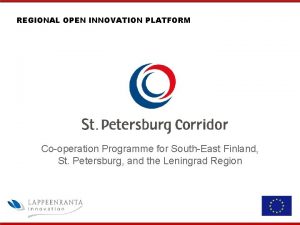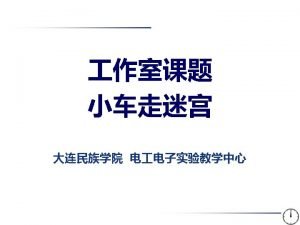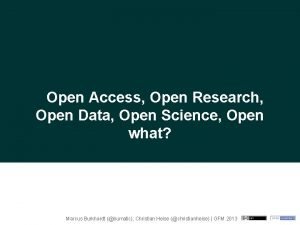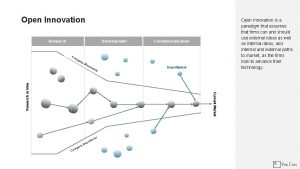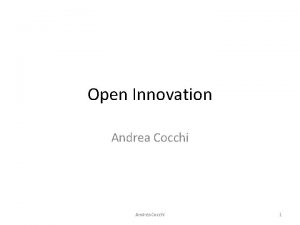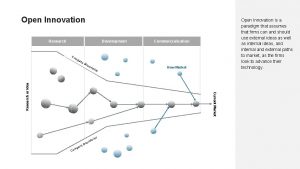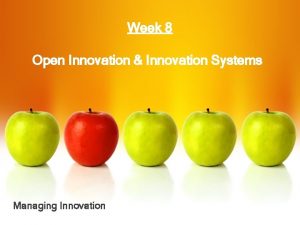Open Innovation in the Weconomy Supporting Innovation Education














































- Slides: 46

Open Innovation in the Weconomy Supporting Innovation Education Reloaded: Nurturing Skills for the Future. The Open Innovation Teaching Handbook teaching slides proposed by Miroslav Špaček Co-funded by the European Union Ref. number: 542203 -LLP-1 -2013 -1 -FI-ERASMUS-ENW

Structure of the lecture o What is the sharing economy? o Collaborative consumption o Weconomy o Pros and cons of the sharing economy o Prospects of the sharing economy o Conclusion

What is the sharing economy? o While individuals have traditionally often seen ownership as the most desirable way to have access to products, increasing numbers of consumers are paying to temporarily access or share products and services rather than buy or own them. o Pricewaterhouse. Coopers has estimated that by 2025, five main sectors of the sharing economy could represent $335 billion in revenue worldwide.

What is the sharing economy? o The sharing economy is a suite of emerging software platforms acting as an intermediary between private buyers and private sellers, allowing them to share their existing resources (Allen, 2015).

What is the sharing economy? The concept of the sharing economy refers to American economist John Kenneth Galbraith especially to his opus The Affluent Society. According to him it is necessary to look for a social balance which cannot be secured by a free market (Galbraith, 1998). John Kenneth "Ken" Galbraith (1908 – 2006) was a Canadian (and later American) economist, public official, and diplomat, and a leading proponent of 20 thcentury American liberalism.

How does the sharing economy actually work? o The uniqueness of the sharing economy consists largely in its ability to exchange the underutilized capacity of resources that individuals already own. o The economics is quite simple: the sharing economy provides users with faster, cheaper and deeper access to knowledge that make existing resources divisible through time and space in more efficient ways (Allen, 2015).

Key imperative of the sharing economy o The central conceit of collaborative consumption is simple: Obtain value from untapped potential residing in goods that are not entirely exploited by their owners. o Having access to goods and skills is much more important than ownership of them (Sacks, 2011).

What all can be shared? o Almost everything can be shared, o Typically: Ø Ø Ø Cars, Accommodation Bicycles, Household appliances Meals

Key components of the sharing economy As per Matofska (2016) the sharing economy consists of ten building blocks: 1) People – they are basic driving force of sharing. Without them the sharing economy wouldn´t come into existence. 2) Production. People, organizations and communities as active participants in sharing economy produce or co-produce products or services. The production is open and accessible for those who wants to produce. 3) Value and the system of exchange. Sharing economy is a hybrid system where various variants of exchange proceed. It typically deals with counteroffers of services, various exchanges, and social capital. The value cannot be perceived exclusively in terms of finance but more broadly. This hybrid motivation system motivates people to participate in productive activity.

Key components of the sharing economy 4) Distribution. Means and resources are distributed through the system which is simultaneously effective and righteous on a local, regional, national and global level. • Shared ownership models like cooperatives, collective purchase and consumption stand for key features of the sharing economy. • At the same time they offer righteous distribution of assets which represents benefits for entire society. 5) The Earth. The sharing economy pay respect to both the Earth and environment protection. The values should be created in consonance with renewable resources and not to harm the planet.

Key components of the sharing economy 6) The power. Through the sharing economy people can become socially and economically independent. o The power is shared or distributed, the infrastructure enabling people to have an access to power and decision making. o The system which enable and support righteous remuneration and reduce inequality and poverty like Fairtrade are supported and preferred.

Key components of the sharing economy 7) Shared law. The mechanism of legislation development and various legal rules should be created by means of democratic system. Such a system facilitates and promotes broad participation of people on all levels. 8) The Communication. Information and knowledge are shared, open and accessible. It is one of the building blocks of the sharing economy. Well-functioning and open communication is essential for the flow, efficiency and sustainability of this system.

Key components of the sharing economy 9) The Culture. All the values of the shared economy serve to the benefits of both individuals and the whole. 10)The Future. Entire system of the sharing economy should have robust and sustainable nature with long-term vision for the future.

Adapting to the sharing economy o In order to effectively respond to challenges of the sharing economy the companies have to either adapt their business models (like Daimler or IKEA) to existing situation or to create quite new business model (Kuhleasing). o It has become evident that newly established or adaptive business models have become not only a threat to established business models and revenue streams but also offer variety of profitable paths by which companies can benefit (Matzler et al, 2015),

Motivation to sharing economy o As for the motivation to the sharing economy the original idea that there is an environmental argument that favors the sharing economy to other business models has been already abandoned. o It was evidenced that the inclination towards the sharing economy neither was triggered by ecological awareness nor by ideological motivation (Garcia, 2013). o In fact the research suggests that the major consumer motivation is self-oriented.

Collaborative consumption o The evolution of the social Web first enabled programmers to share code (Linux), then allowed people to share their lives (Facebook), and most recently encouraged creators to share their content (You. Tube). o The central conceit of collaborative consumption is simple: Access to goods and skills is more important than ownership of them

Collaborative consumption o If the people formerly known as consumers begin consuming 10% less and peering 10% more, the effect on margins of traditional corporations is going to be disproportionately greater. o The sharing economy is a suite of emerging software platforms acting as an intermediary between private buyers and private sellers, allowing them to share their existing resources. That is why we speak about the sharing economy.

Collaborative consumption o The sharing economy is a market catalysed by disruptive technologies. Communication technologies have drastically reduced the costs of coordinating resources. o It is now marvellously cheap and simple to discover if there's an idle car or an empty room around the corner.

Classification of collaborative consumption o According to Botsman & Rogers (2010) collaborative consumption can be divided into three main types: 1) The first mode represents product service systems, which allow members to share multiple products that are owned by companies or by private persons. o Examples of product-service systems are carsharing services like Zipcar and peer-to-peer sharing platforms such as the website Zilok. com.

Classification of collaborative consumption 2) The second type concerns redistribution markets. Peer-to-peer matching or social networks allow the re-ownership of a product. Examples of redistribution markets include the online platforms Neighbor. Goods. com and Thred. UP. com. 3) The third type. The access can be derived through collaborative lifestyles in which people share similar interests and help each other with less tangible assets such as money, space or time; this sharing is mostly enabled through digital technology. This category covers a wide variety of collaboration systems. Examples range from garden sharing (landshare. net) to systems of skill sharing such as Taskrabbit (taskrabbit. com).

How to respond to collaborative consumption? o There at least six options how the companies can respond to the concept of collaborative consumption Ø by selling use of a product rather than ownership, Ø by supporting customers in their desire to resell goods, Ø by exploiting unused resources and capacities, Ø by providing repair and maintenance services, Ø by using collaborative consumption to target new customers, Ø by developing entirely new business models enabled by collaborative consumption.

The biggest firms in the sharing economy branch

The examples of the sharing economy

Uber story The company uses mobile application to interconnect drivers with customers to bring joint satisfaction to both parties. Then main objective is to change the way of people´s transportation in the city. The company doesn´t have the ambition to offer the quickest or the cheapest service but to change the service to the better. The success of this business depends on mutual satisfaction, optimum balancing supply and demand etc. By this way the company generates value added for the customers Uber Technologies Inc. is an American multinational online transportation network company headquartered in San Francisco, California.

Airbnb o Airbnb is a company and website for people to list, find, and rent lodging. It has over 1, 500, 000 listings in 34, 000 cities and 191 countries. o Founded in August 2008 and headquartered in San Francisco, California, the company is privately owned and operated. The future of Air. Bn. B is not only in monetizing the houses but in monetizing all the stuff in houses, front yards, backyards and drive ways.

Boat sharing o Four Hawaii families share the cost and use of one boat for weekend fishing trips and fun outings. o It not only reduces the number of boats that need to be produced and purchased, it reduces the storage space needed, and can foster trust and camaraderie among neighbours.

The knowledge-intensive company and the economy of sharing o As opposed to preceding economic regimes, the post- industrial society is to a lesser extent dependent on production factors that are subject to scarcity. o Instead, knowledge tends to grow rather than being consumed as it is shared with others. o When examining the practices of knowledgeintensive companies, an ethics of sharing underlying to the use of all knowledge needs to be recognized.

The knowledge-intensive company and the economy of sharing o Rather than conceiving of knowledge as being an organizational resource that is derived from previous economic regimes, the analysis of knowledge needs to be grounded in a different perspective.

Benefits of the sharing economy o They benefit from an aura that seems to combine convenience with a patina of revolution. o The idea of a "sharing" economy sounds so groovy: Ø environmentally correct, Ø politically neutral, Ø anti-consumerist etc. o All of it wrapped in the warm, fuzzy vocabulary of "sharing".

The dark side of the sharing economy o The risks involve everything from Ø income instability (the worker, rather than the firm, has to absorb the brunt of demand shocks or price cuts); Ø to irreversible capital investments (Uber and Lyft have infamously pushed drivers to buy new cars by promising big returns that never materialized); Ø to unforeseen criminal liabilities (what happens if an Airbnb guest turns your home into a brothel? ); to fewer protections in the event of catastrophe (no access to programs such as workers' comp).

What is the Weconomy? o The WEconomy is defined as a global movement, connecting online, in order to establish a new form of consumerism and economic activity. o In the WEconomy everyone does business with one another and everyone profits from one another.

Weconomy principles o Success in today’s WEconomy means doing it together, for the good of the many, not just the few. o It means returning to a hand made, one of a kind world, where profit is also purposeful, where creativity, socialization and trust, and are competencies.

What does the WEconomy consist of? o The WEconomy consists of seven trends. Six different views on a modern economy and a wildcard, connecting the other trends within the WEconomy. o The seven trends include: 1. the circular economy, 2. the functional economy, 3. the bio-based economy, 4. the collaborative economy, 5. the sharing economy and, finally, 6. the self-production (or 3 D economy). 7. Internet of Things (IOT). Collectively, these are labelled as the Weconomy.

Seven trends in WEconomy

The nature of the WEconomy o The nature of Weconomy relates to the concept of psychological value (Carvalho & Jonker, 2015). o It influences and transforms an individual´s mentality (mind set value). o This type of value is dominant in what can be referred to social products. o This value is related to individual self-realization, enhancement of skills or new knowledge and experiences that influence a person with new perceptions and how to behave.

WEconomization o Weconomy concept demonstrates how many seemingly unconnected movements are paving the way for a new economy that is sustainable and circular in nature. o In this respect it was coined the term “WEconomization”. WEconomized organizations are more valuable, more effective and empower themselves, other individuals (their prosumers: producing-consumers) and the entire community. o WEconomized organizations are oriented to the future. Success in today’s WEconomy means doing it together, for the good of the many, not just the few. o It means returning to a hand-made, one of a kind world, where profit is also purposeful, where creativity, socialization and trust are competencies.

WEconomy index o The WEconomy index is a self-audit tool developed for organizations by Prof. Dr. Jan Jonker. o The aim of the index is to help organizations gain insight in their performance on seven trends. o The trends flow from academic material that has not been applied in business before and thus offers new insights for organizations. o It aims to trigger organizations to be self critical, set targets for future (strategic) development and help them identify opportunities for working towards a more sustainable way of manufacturing and organizing

WEconomy index o Benefits of the WEconomy Index for the organization: o Your company will gain insight in what its current position in the new economic movement is o You will get an indicator score of how well you are doing in several economic areas o The index gives risk identification o The index provides you with industry benchmarks o The index can increase internal communication about this topic in your company

Fight. Me Case o As part of a new wave of social platforms, the Fight. Me app has championed the concept of challenges and social movements. Skateboarders, parkour enthusiasts, rappers and poets are all part of an engaged community currently using the platform, with the company wanting to harness this community in order to drive the WEconomy.

Fight. Me Case o How Fight. Me fits into this WEconomy is the way in which it will not rely on only likes or comments, but instead find different revenue streams in which to monetise its audience - though the company does not yet offer any specifics on what these „different revenue streams“ may be.

What is Fight. Me actually doing? o Through a smartphone app, Fight. Me gives users 30 seconds to create a video about whatever they want and can either start their own video challenge or join in one that is already live - like PETA's latest anti-fur protest.

Founder´s words o Jamie Lorenz Chairman and Founder of Fight. Me added, "Fight. Me focuses on 'real' social interaction online. o "Fight. Me creates a friendly environment based on its „joining in“ mechanic, giving purpose and context to each video. o Strength comes in numbers and the support of others participating in a challenge gives freedom of expression away from judgment. "

Prospects of the sharing economy o Companies that produce product or services are fully aware of growing potential of the sharing economy which will be flourishing no matter if they join or not. o Following figures are speaking for themselves: o Expected growth of the sales is estimated at 335 Bill. USD by the year 2025. o Currently 7, 500 sharing platforms exist globally (Mafolska, 2016). o Car sharing revenues in North America are expected to hit 3. 3 bill. USD by 2016. (Sacks, 2011). o Similarly Botsman & Rogers (2010) deem that consumer peer-to-peer rental market will achieve 26 Bill. USD.

Prospects of the sharing economy o The sharing economy is becoming more influencing in non-profit sector as well. o It places accent on nonfinancial benefits of the sharing economy like resource sustainability, individual empowerment, the building of interpersonal community and trust. o The sharing economy might be the way forward for humankind, but it might be or might not be monetizable in the long run. o Non-profit sector should provide sharing economy with a stewardship (Leong, 2015).

Conclusions o The sharing economy is gaining ground, fundamentally altering how people own and consume. o Even if people appreciate all the features and benefits of sharing economy they are still inclined to consider sharing economy as a complementary business model to the traditional model which is based on the ownership. o Companies can also participate in collaborative consumption economy by thinking in terms of excess capacity, sharing unused assets, facilities etc. o The contribution to the “community” plays an important role even if it is not a focus for global companies. o Shared services might be an opportunity in regions with high level of unemployment.

Thank you! The slides are licensed under a Creative Commons Attribution-Share. Alike 4. 0 Unported License. Visit www. oi-net. eu to learn more about the project and download the free book Innovation Education Reloaded: Nurturing Skills for the Future. The Open Innovation Teaching Handbook This project has been funded with support from the European Commission. This publication reflects the views only of the author, and the Commission cannot be held responsible for any use which may be made of the information contained therein. 46 Programme: ERASMUS # 542203 -LLP-1 -2013 -1 -FI-ERASMUS-ENW
 Open innovation open science open to the world
Open innovation open science open to the world Besigheidsplan
Besigheidsplan Disruptive and radical innovation
Disruptive and radical innovation Open innovation canvas
Open innovation canvas Open innovation platform tsmc
Open innovation platform tsmc Open innovation collaborative
Open innovation collaborative Open innovation platform
Open innovation platform Innovation workshop sydney
Innovation workshop sydney Measuring innovation in education
Measuring innovation in education Hình ảnh bộ gõ cơ thể búng tay
Hình ảnh bộ gõ cơ thể búng tay Lp html
Lp html Bổ thể
Bổ thể Tỉ lệ cơ thể trẻ em
Tỉ lệ cơ thể trẻ em Chó sói
Chó sói Tư thế worm breton là gì
Tư thế worm breton là gì Alleluia hat len nguoi oi
Alleluia hat len nguoi oi Kể tên các môn thể thao
Kể tên các môn thể thao Thế nào là hệ số cao nhất
Thế nào là hệ số cao nhất Các châu lục và đại dương trên thế giới
Các châu lục và đại dương trên thế giới Cong thức tính động năng
Cong thức tính động năng Trời xanh đây là của chúng ta thể thơ
Trời xanh đây là của chúng ta thể thơ Mật thư anh em như thể tay chân
Mật thư anh em như thể tay chân Làm thế nào để 102-1=99
Làm thế nào để 102-1=99 Phản ứng thế ankan
Phản ứng thế ankan Các châu lục và đại dương trên thế giới
Các châu lục và đại dương trên thế giới Thơ thất ngôn tứ tuyệt đường luật
Thơ thất ngôn tứ tuyệt đường luật Quá trình desamine hóa có thể tạo ra
Quá trình desamine hóa có thể tạo ra Một số thể thơ truyền thống
Một số thể thơ truyền thống Cái miệng xinh xinh thế chỉ nói điều hay thôi
Cái miệng xinh xinh thế chỉ nói điều hay thôi Vẽ hình chiếu vuông góc của vật thể sau
Vẽ hình chiếu vuông góc của vật thể sau Thế nào là sự mỏi cơ
Thế nào là sự mỏi cơ đặc điểm cơ thể của người tối cổ
đặc điểm cơ thể của người tối cổ V cc cc
V cc cc Vẽ hình chiếu đứng bằng cạnh của vật thể
Vẽ hình chiếu đứng bằng cạnh của vật thể Tia chieu sa te
Tia chieu sa te Thẻ vin
Thẻ vin đại từ thay thế
đại từ thay thế điện thế nghỉ
điện thế nghỉ Tư thế ngồi viết
Tư thế ngồi viết Diễn thế sinh thái là
Diễn thế sinh thái là Các loại đột biến cấu trúc nhiễm sắc thể
Các loại đột biến cấu trúc nhiễm sắc thể Các số nguyên tố
Các số nguyên tố Tư thế ngồi viết
Tư thế ngồi viết Lời thề hippocrates
Lời thề hippocrates Thiếu nhi thế giới liên hoan
Thiếu nhi thế giới liên hoan ưu thế lai là gì
ưu thế lai là gì Hươu thường đẻ mỗi lứa mấy con
Hươu thường đẻ mỗi lứa mấy con






